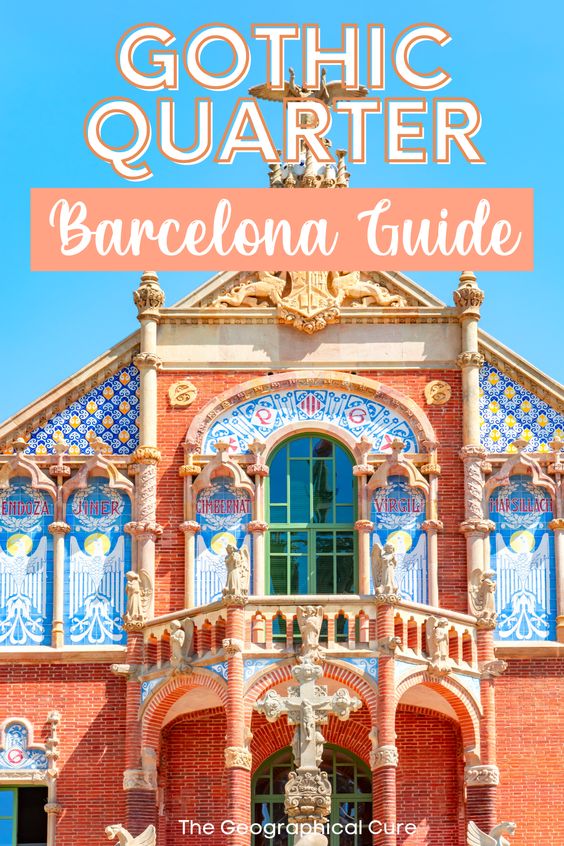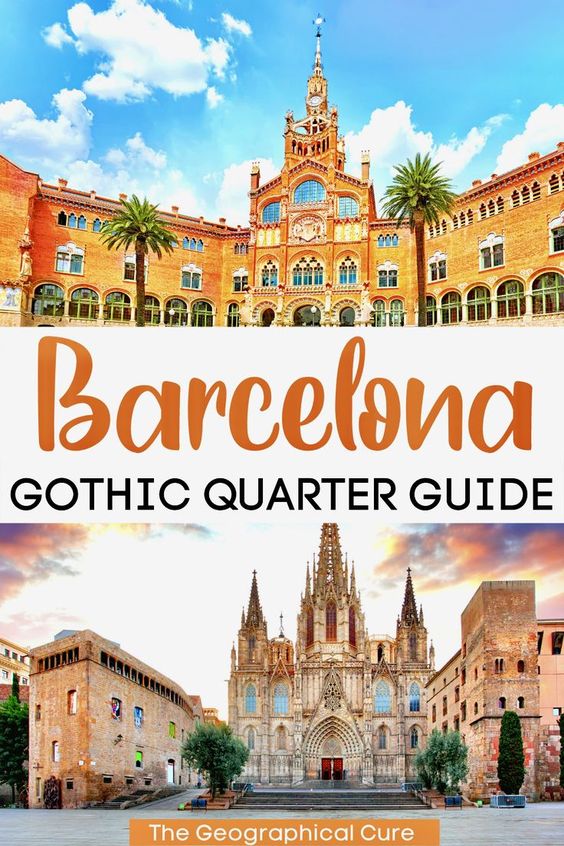The Gothic Quarter, also known as Barrio Gótico, is the vibrant heart of Barcelona’s historic district. It’s a destination that offers a delightful blend of history, culture, and architectural wonders.
The Gothic Quarter is the heart of Barcelona, an evocative and mysterious place. It’s a bustling labyrinthian maze, a warren of dark narrow streets that wind between stone buildings linking squares large and small.
The Gothic Quarter is home to Roman ruins, medieval monuments, beautiful churches, and cobbled lanes. There’s no shortage of eye candy.
The Gothic Quarter is Barcelona’s birthplace. It used to be the Roman village of Barcino. Barcelona was enclosed within protective walls until the 1850s.
Later, the Gothic Quarter was an enclave frequented by artists like Picasso, Dali, Miro, and Antoni Gaudi. Though it has plenty of ancient buildings and just drips in Gothic, some Neo-Gothic elements were added in the 19th century.
The Gothic Quarter is located between La Rambla and the Via Laietana. You can get there via Metro Line 3 Liceu station or Metro Line 4 Jaume I Station.
You might want to have a paper map, as sometimes it’s difficult to get GPS signals. But getting lost in the Gothic Quarter is a quintessential Barcelona experience.
Top Attractions in the Gothic Quarter
Here are my picks for the best things to do and see in and around Barcelona’s Gothic Quarter.
To see its all, you can book a small group guided walking tour of the Gothic Quarter or your own private tour of the neighborhood.
1. Barcelona Cathedral
The Gothic Quarter begins at the Pla de la Seu. There, street magicians and human statues panhandle in front of Barcelona Cathedral.
The cathedral is a top attraction in the Gothic Quarter. It’s a grand monument dating from the 13th to 15th centuries. Its official name is the Cathedral of the Holy Cross and Saint Eulalia.
The cathedral’s Neo-Gothic facade is stunning. It’s not ancient, receiving facelifts in the 19th and 20th century.
Sit by the steps and absorb its grandiosity. You can visit the church for free from 8:00 am to 12:45 pm and 5:45 pm to 7:30 pm. Otherwise, entry is by donation.
Inside, the cathedral has a wide central nave and two side aisles, separated by colonnades. The cathedral has 28 richly decorated chapels, an ornate finely carved choir, and a peaceful cloister with bubbling fountains.
Behind the high altar is the Bishop’s chair. You’ll also find the crypt of Saint Eulalia, the patron saint to whom the cathedral is dedicated.
The cloisters are the highlight. Arcaded walkways surround a central courtyard filled with tropical trees.
A short elevator ride takes you to the top of the cathedral for stunning city views. For the best view of cathedral itself, take the elevator to the rooftop of the next door Hotel Colon.
Pro Tip: A dress code is strictly enforced. No tank tops or shorts or skirts above the knee.
2. Basilica of Santa Maria del Mar
Another top attraction in th Gothic Quarter is the beautiful basilica of St. Mary of the Sea. It’s tucked away in the El Born neighborhood.
The basilica is really one of the jewels of the historic center. With roots tracing back to Roman times, the 4th century church is one of the finest surviving examples of Catalan Gothic architecture.
On the exterior, the church has three facades and two symmetrical towers. Because the area is rather claustrophobic, it can be hard to get a full view. The round rose window is considered one of the largest in the world.
Inside, the church has a light and airy feel, with many stained glass windows. You’ll also see beautiful Gothic arches, a monumental altar, and other decorations. The church was forcibly decluttered of any Baroque decor that was later added.
The church is free for self-guided visits. If you spend a few euros for a guided tour, you’ll have access to the church’s three amazing terraces, with breathtaking views. There’s also a longer tour at dusk, where you can visit at a more leisurely pace without crowds.
3. Picasso Museum
The setting of the Picasso Museum is stunning. If you’re an art lover (or even ifyoure’ not), the museum is a must visit destination in the Gothic Quarter.
It’s lodged in five adjoining medieval stone mansions in Barcelona’s funky-chic El Born neighborhood, with a gorgeous terrace. The palaces date from the 13th to 14th centuries, and are characteristic of the Catalan civic Gothic style.
Founded in 1963, the museum was launched with a donation of 574 works by Picasso’s secretary, Jaime Sabartes. In 1970, Picasso himself donated 800 more pieces.
For Picasso, Barcelona was where it all began. He lived in Barcelona during his early apprenticeship. Barcelona is where he wanted his namesake museum.
At the museum, you can enjoy an extensive collection of Picasso’s work, certainly the best collection in Spain. There’s over 3,000 pieces, mostly from Picasso’s formative years in Barcelona.
By experiencing his youthful works, you can better understand his later abstract pieces and how he became the greatest artist of the 20th century. To further this cause, the museum is arranged chronologically with good descriptions.
You’ll definitely want to pre-book a skip the line ticket. You can also book a guided tour of the Picasso Museum or a Picasso-themed tour of the city.
4. Placa Reial
The 19th century Place Reial, or Royal Square, is one of Barcelona’s ancient and beautifully designed squares. If your’e in the Gothic Quarter, you can’t miss it.
It’s a lively pedestrianized hangout spot. During the day, visitors laze in the square or indulge at the many tapas restaurants.
Placa Reial has charming yellow buildings with Neo-Classical pillars and uniform archways. It’s dotted with iron lampposts and palm trees. The square was the work of architect Daniel Molina, completed in 1848.
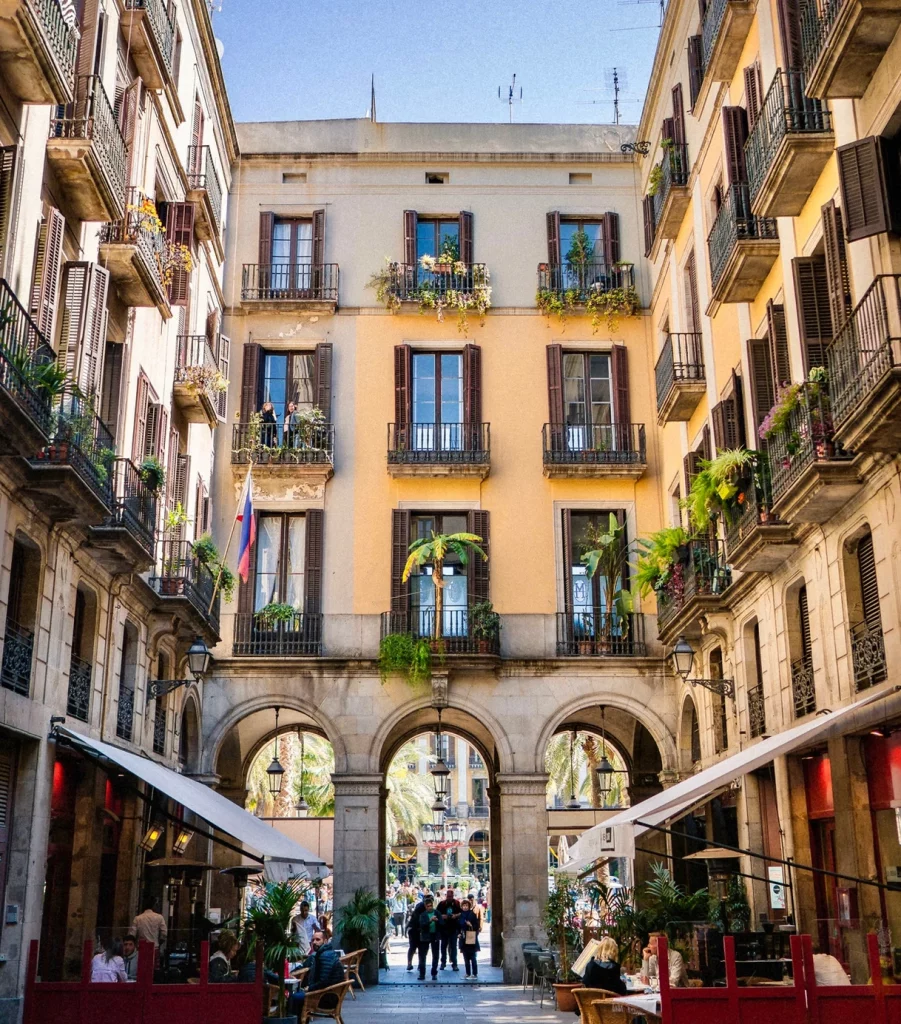
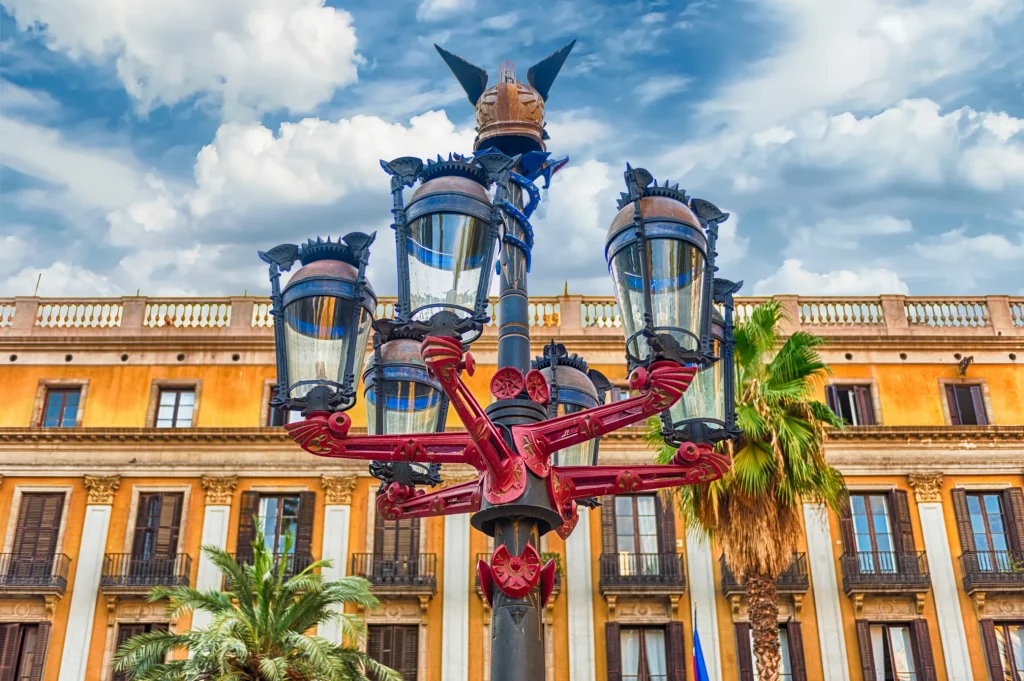
In the center is the classically designed Fountain of Three Graces, by architect Antoni Rovira i Trias.
The graces represent charm, beauty, and creativity. The Modernist lampposts were Gaudi’s first government sponsored project. The six-armed lamps are topped by whimsical winged helmets.
Placa Reial is an excellent place to start your stroll in the Gothic Quarter because it’s just off La Rambla.
READ: Guide to Modernist Architecture in the Eixample Neighborhood
5. Palau Guell
Located off La Rambla in the El Raval neighborhood is Palau Güell, or Güell Palace. The mansion doesn’t immediately scream Gaudi.
It’s more traditional and dark, almost like a luxurious Venetian palace. It has a creepy Gothic vibe. And I mean that in a good way. Don’t miss this wondrous UNESCO-listed building.
The Palau Güell commission came at the outset of Gaudi’s career, when he was establishing himself as an architect. Built between 1886-88, it was designed for Eusebi Guell.
He was a prominent industrialist and Gaudi’s greatest patron. It was the family’s residence until they moved to Park Güell in 1910. The original period furniture is still in place.
The restored interior is exquisitely curvy. The home centers on a monumental three story main room that was used to entertain wealthy guests. It has a high ceiling crowned by a parabolic dome, covered in cobalt honeycomb tiles.
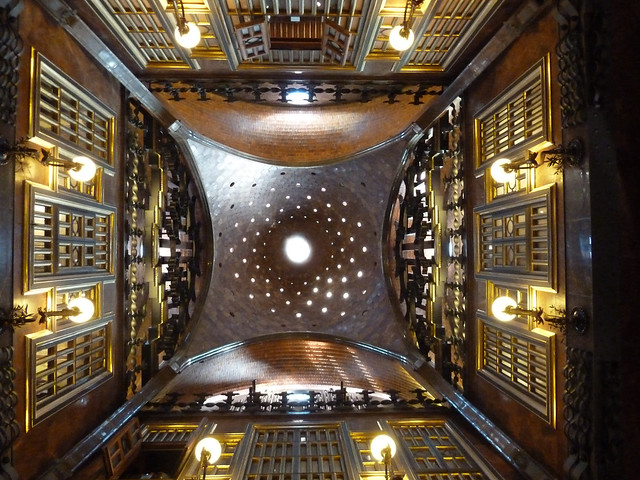
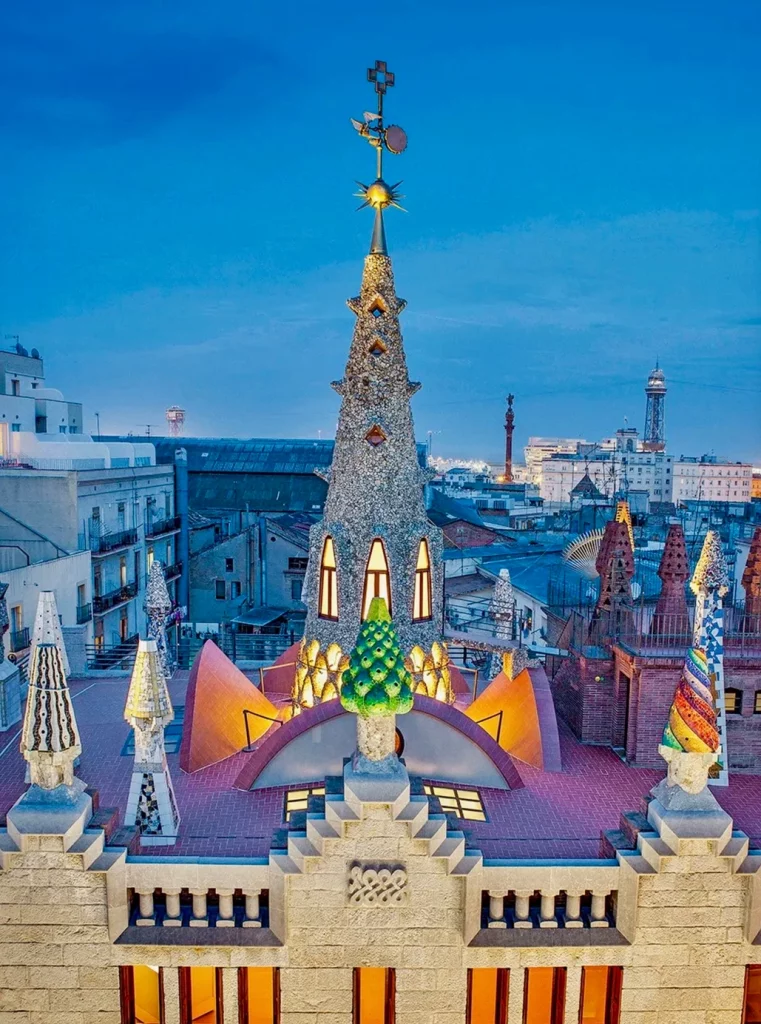
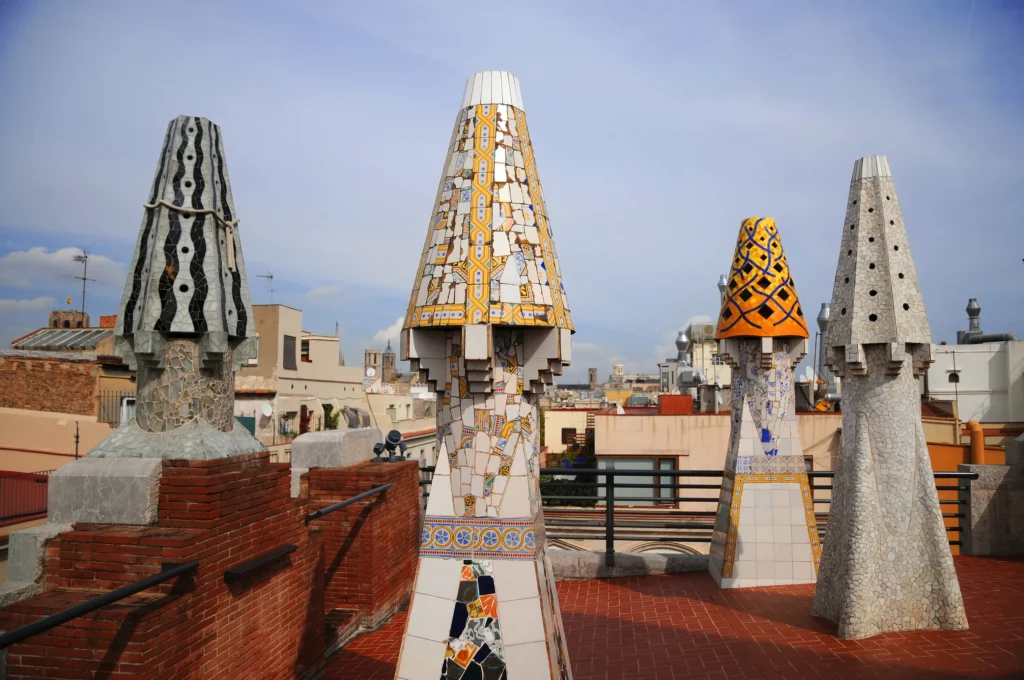
Small holes are perforated near the top. Lanterns are hung at night to give the appearance of a starlit sky. It’s almost like a planetarium experience.
Most of Gaudi’s experimentation is in the basement, which was used as a horse stable. It reflects Gaudi’s early enthusiasm for using natural shapes, with vaulted pillars in the form of mushrooms.
The loopy rainbow roof, like many Gaudi creations, also features colorful ceramic shapes and 20 chimneys. One conical chimney looks like a stack of green olives smooshed together. Gaudi tended to put his most innovative work in the top and bottom of buildings to avoid the ire of his clients.
>>> Click here to book a skip the line ticket to Palau Guell
6. Els Quatre Gats
Els Quatre Gats is a famous tapas restaurant and bar housed in a beautiful Modernist building, Casa Marti.
It was designed by Josep Puig i Cadalfach, one of the greatest architects of the era. The bar was conceived as the Spanish equivalent to Paris’ Le Chat Noir cabaret hall.
Els Quatre Gats was embraced straight away by the Barcelona bohemians. A young Picasso frequented the place, and hosted his first one man show there in 1900. Antoni Gaudi was also a regular customer.
The interior is trapped in time, a time capsule of a bygone era. It has black and white portraits and sketches by Picasso. But prices have risen and tourists have replaced the former artsy crowd.
7. Street Art
The Gothic Quarter is home to some of Barcelona’s finest street art. It makes the Gothic Quarter a fascinating blend of old and new, with art alive on the streets.
Be sure to see the 26 foot long The World Begins With Every Kiss mural near the cathedral.
Created by Catalan artist and photographer Joan Fontcubertat, the mural was unveiled in 2014. It commemorates the 300 year anniversary of the Catalan surrender in the Spanish War of Succession.
The photographer asked locals to send in photographs that expressed a moment of freedom. The photographs were placed on tiles and arranged in a mural. From afar, the arrangement looks like a poignant (or perhaps erotic) kiss. Up close, you see a world in each image.
A favorite playground of street artists is Three Chimneys, an urban park built specially for street art. There’s a long wall that artists can paint on with fear of fine.
Another iconic mural is a tribute to artist Joan Miro. You’ll find it on the corner of Carrer de Sant Pau and Carrer de la Riereta. Created by Sixe Paredes, it has Miro’s characteristic playful colors and shapes.
The trendy El Raval neighborhood is also home to plenty of street art and graffiti. You’ll find a mishmash of large murals, small installations, and ever-changing street art. You can book a 2 hour guided street art tour in this neighborhood.
The Barcelona Museum of Contemporary Art in the Placa dels Angels, has a long wall painting by the famed Keith Haring. The square is also decorated with street art.
>>> Click here to book a ticket to the contemporary art museum
8. Puerta del Bisbe | The Bishop’s Bridge
This might be the most famous spot in the Gothic Quarter. The Bishop’s Bridge isn’t technically a bridge.
It’s a covered gallery connecting the Government Palace and the Canon’s House. The Neo-Gothic bridge itself isn’t terribly old, though it blends in well with its frilly stonework and gargoyles.
It was built in 1928 for the Barcelona International Exposition by architect Joan Rubio i Bellver. He aimed to build a series of similar bridges, but his project was nixed by the government.
A bit pissed off, he incorporated a hidden skull with a dagger on the bridge’s underside, which has generated myths.
One legend holds that if you make a wish when you pass under the bridge, while looking at the skull at its base, your wish will come true. Another holds that, if you see the skull, you’ll fall pray to an evil spell.
In the 4th century, Barcelona was originally protected by four fortified walls. One such ancient turret can be glimpsed at the Puerta del Bisbe.
Immediately past the bridge is a facade with the Statue of Saint Jordi. It was carved by Pere Johan in the 15th century. Jordi was a legendary Catalonian knight who valiantly rescued a princess from a dragon.
When Jordi slew the dragon, a rose bush grew. Jordi gifted his love a rose. Now, on April 23, lovers celebrate St. Jordi’s day with an exchange of a rose or gift.
9. Plaza del Pi
This tiny square is the perfect getaway from Barcelona’s hurly burly. It’s just off La Rambla at the end of Petritxol Street.
Named the Square of Pines, the main attraction is the Church of Santa Maria del Pi. It’s a 14th century Catalan Gothic church, famous for its rose window. Much of it was gutted by a fire during the Spanish Civil War in 1936.
You can climb the bell tower for views. And there are frequent evening concerts inside the church.
The Plaza del Pi is surrounded by ornate facades, antique shops, and cafes. It’s also renowned for its artisanal food market held the first and third Friday, Saturday, and Sunday of the month.
10. The Mailbox and the Magic Turtle
Another attraction is a small Modernist style mailbox on the facade of the House of the Archdeacon. It’s actually free to enter this building. You can climb the balcony in the courtyard for views of the Barcelona Cathedral.
To the right of the doorway is a mailbox designed by Lluis Domenech i Montaner, for the local lawyers association. The design is rich in symbolism, an allegory of justice. It was carved by sculptor Alfons Juyol.
Swallows represent the transcendency of justice. Ivy represents the tangled bureaucracy confronting lawyers. And the turtle suggests the grindingly slow pace of the judicial system.
Be sure to touch the turtle. Legend holds it will be will cure you any evil spell you might have been infected with by the skull and dagger at the Bishop’s Bridge
11. Temple of Augustus
The Gothic Quarter is home to Barcelona’s most ancient hidden treasure. It’s a Roman temple, dating from the 1st century B.C., hidden behind the cathedral.
It’s just off Placa Sant Jaume on Carrer del Paradis. An ancient sign announces the improbable temple.
Emperor Tiberius built the Temple of Augustus to honor his stepfather Emperor Augustus. The temple was intended as a focal point of a Roman forum. At some point, it was mostly demolished. The ruins weren’t discovered until the late 19th century.
Now, in a courtyard, you’ll find four 30 foot tall ancient Roman Corinthian columns, which somehow survived 2,000 years. Dating from the first century B.C., they were part of ancient Barcelona’s biggest structure — a 120 foot long temple that extended from the temple to Barcino’s forum.
12. Placa Nova
In Placa Nova, you’ll find two circular Roman towers flank Bisbe Gate on the main street. These were once the monumental entryways to the Roman city of Barcino. The city’s name may have come from the Roman general Barca.
Historians and archaeologists estimate that, at the Roman village of Barcino’s peak, the Roman city walls were 25 feet high with 74 towers.
In 1994, the sculpture Barcino by Joan Brossa was installed in the square. Although the six bronze and aluminum sculptures spell out a single word, they’re individual pieces of art.
On the other side of Placa Nova lies the Architects’ Association. There are a series of sand friezes around the facade with scribblings designed by Pablo Picasso.
On the weekends, a market pops up in the square. Perhaps you can discover an antique or souvenir from Catalonia.
13. Placa de Sant Jaume
Placa de Sant Jaume is a stately square smack in center of the Gothic Quarter. Its name derives from the Church of St. James that formerly stood there. The square was once a Roman forum.
The black-bricked square houses two important government buildings — the Palau de la Generalitat and the Barcelona City Hall.
The Generalitat is closed to the public. But city hall houses the tourist office. You should go in and gape at the great Gothic staircase and sculptures dotting the interior.
Placa de Sant Jaume has some beautiful wrought iron lamps. The square is also the time-honored site of demonstrations and festivals.
All main roads in Barcelona cross the plaza. Carrer de Ferran, which branches off the square, is a classic Barcelona thoroughfare.
14. Museum of the History of Barcelona
In an unassuming building for the Gothic Quarter, you’ll find the delightful Museum of the History of Barcelona. The museum is Barcelona’s principal Roman-themed museum, and shares space with the former Royal Palace.
It’s believed to stand in a medieval courtyard once used by King Ferdinand and Queen Isabella to celebrate the return of Christopher Columbus.
Grab the essential audio guide and get ready for a listen. There are also English handouts. It’s best to start with a short introductory video in the theater.
In the basement level, the museum really comes to life. Down a special elevator, you’ll come to what seems like a mysterious underground labyrinth.
There, you’ll find Roman ruins dating from the time of Emperor Augustus — wall fragments, pavements, Roman baths, and even an ancient sewage system.
15. Palau Reial Major in Placa del Rei
The Palau Reial Major rises up at the back of the Placa del Rei, with the octagonal Watchtower of King Marti on one side. Palau Reial Major is part of the long history of Barcelona.
It’s a complex of three historic buildings that once served as the residence of successive counts and kings in the 13th to 15th centuries.
The three buildings are the Salon of Tinell (great hall), the palatine Chapel of St. Agatha (royal chapel), and the Lieutenant’s Palace (viceroy’s residence with a lovely garden). You’ll see traces of Visigoth and Romanesque features.
This is where you’ll see the famous steps on which Columbus met Queen Isabella. You can visit the Royal Palace as part of your visit to the Barcelona History Museum.
16. Palau de la Musica
Perhaps Barcelona’s most beautiful and photogenic spot is the UNESCO-listed Palau de la Musica Catalana. The palace is a gaudy rose-covered wonderland.
It’s a magnificent concert hall designed in 1905-08 by Lluis Domenech i Montaner — an architect who was just as famous as Gaudi at the time.
You have to see it to believe it. Musicians love its acoustics. Tourists love its unique design. It’s a veritable symphony of stained glass, mosaics, and sculptures.
Palau de la Musica is located along a claustrophobic, densely packed street in the Gothic Quarter. Montaner countered the claustrophobia with color and levity. The arches and intricate mosaic adorned pillars draw your eye to the roofline. Stained glass windows bring in the natural light.
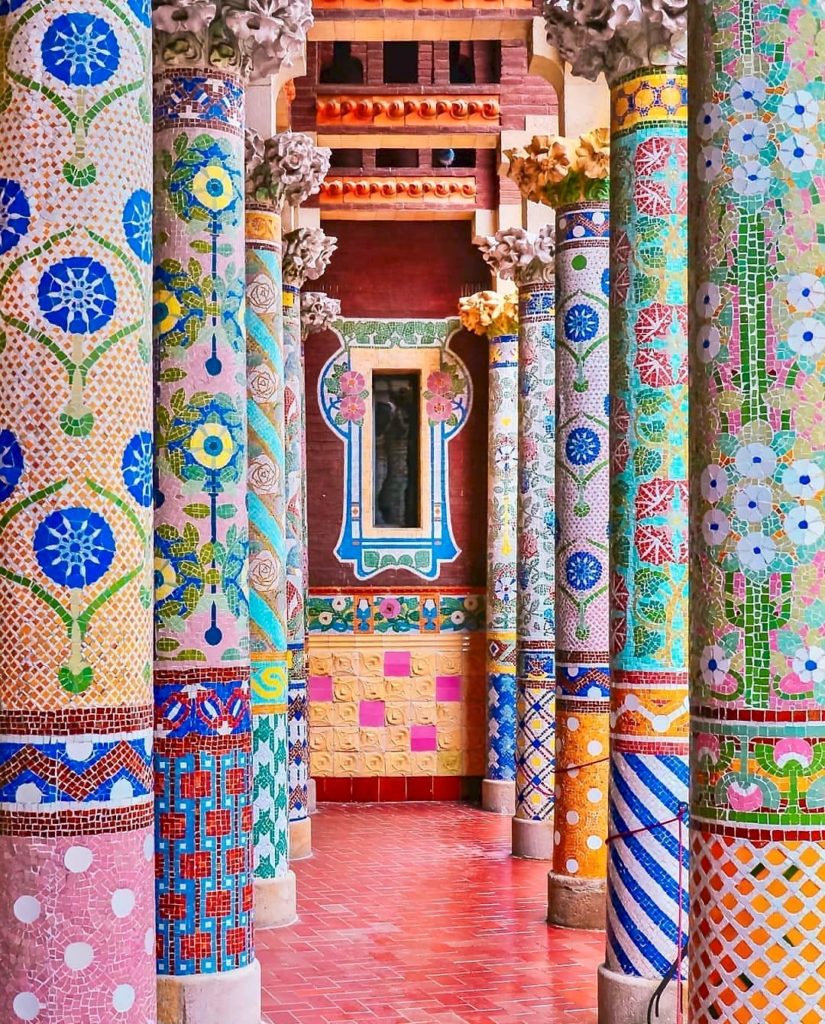
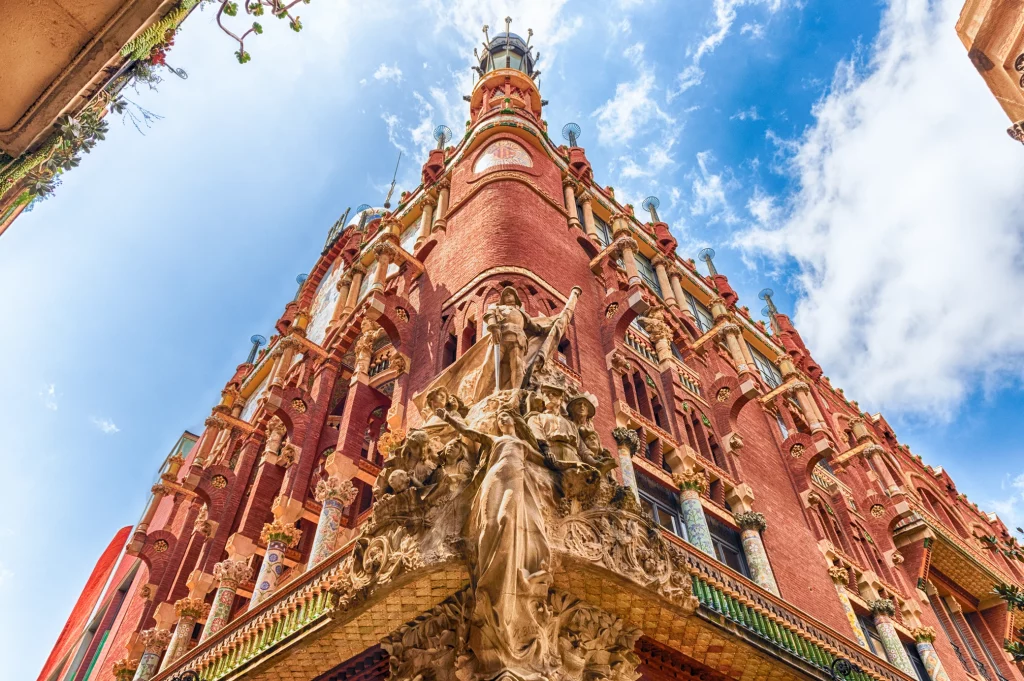
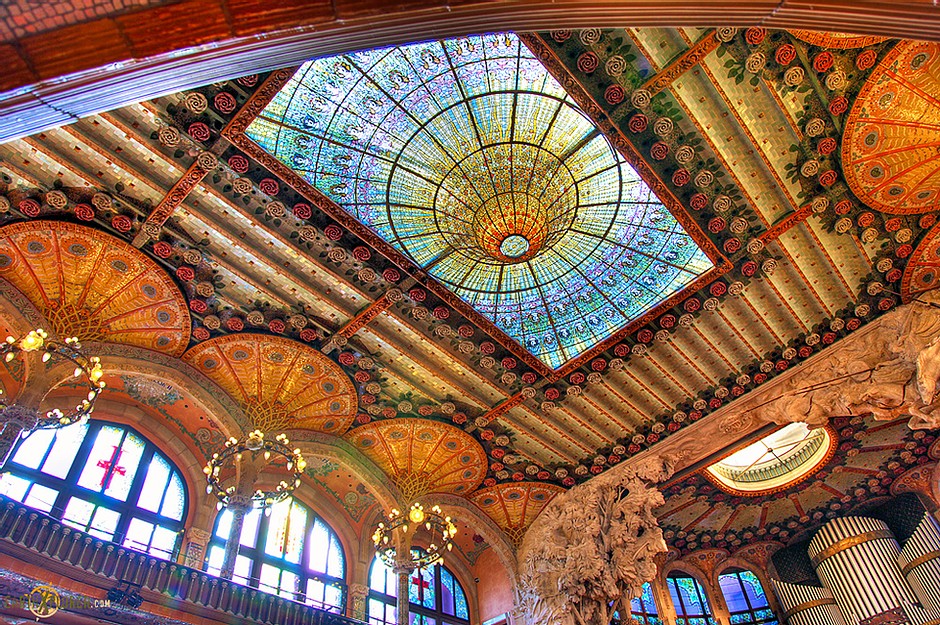
But the beautiful mosaicked facade is upstaged by the interior. The richly decorated auditorium is almost overwhelming.
The piece de resistance is the intricate stained glass ceiling by Antoni Rigalt. Iron and glass chandeliers create a starry night effect.
And sculptures curve up the sides of the stage, including a glowering Beethoven and wind blown Valkeries from Richard Wagner’s operas.
Click here to pre-book a ticket to Palau de la Musica. Click here to book a 1 hour guided tour.
17. Santa Caterina Market
If you’re a foodie who can’t stomach elbowing your way through over-crowded La Boqueria, a great alternative is Mercat de Sant Caterina on the edge of the El Born district. The eye catching market hall is another piece of outstanding architecture in Barcelona, with 100 stalls on three levels.
Seven years in the making and debuting in 2005, Santa Caterina’s defining feature is its theatrical Gaudi-inspired roof. It’s a gentle wave adorned with a magic carpet of 325,000 colorful ceramic tiles from Seville.
It was designed by the husband and wife team of Enric Miralles and Benedeta Tagliabue, who are famous for their promiscuously expensive projects.
Computer wizardry helped design the form of the roof. But the individual tiles had to be cut by hand.
This makes the market design both ultra modern and old in spirit and technique. The latter seems befitting since the market is right near Barcelona Cathedral and Santa Maria del Mar.
18. La Boqueria Market
About halfway down Las Ramblas is the legendary 19th century food market, La Boqueria.
It’s Barcelona’s beating heart, evolving from a rough and tumble purveyor of goods to a bona fide foodie destination.
The market is well worth checking out, especially if you need fresh fruit juice or a smoothie. Inspect its myriad wine bodegas and take home a quaffable souvenir.
You can book a food and market tour, which includes Boqueria.
19. Frederic Mares Museum
Next to Barcelona Cathedral is the Frederic Mares Museum. This delightful small museum houses the weird collection of local sculptor Frederic Mares.
Mares was a packrat collector and horder. There’s an entire floor dedicated to his curiosities — jewelry, ladies’ fans, keys, clocks, glasses, etc.
Mares collected a priceless variety of Spanish sculptures throughout his life, ranging from the ancient world to 19th century Catalonian pieces.
You’ll find plenty of Roman statues and a veritable warehouse of Romanesque and Christian art (especially crucifixes). The museum experience is tantamount to perusing a thrift shop or flea market.
The museum also has a zen courtyard with orange trees. Between the lack of tourists and the tranquil courtyard, this is a secret escapist experience in Barcelona.
20. Placa de Sant Felip Neri
Placa de Sant Felip Neri is a romantic quaint square in the Gothic quarter, a hidden gem in Barcelona. But, although it’s a pretty spot, it has a tragic past.
In 1926, the famous Catalan architect Antoni Gaudi was struck by a tram in the square. He died two days later in hospital.
During the Spanish Civil War, 42 people hid in the cellars of the square’s Baroque church, the Church of St. Phillipe Neri.
A 1938 bomb from Franco’s troops exploded there and killed everyone. Today, the pockmarked church still bears scars from the genocidal bombardment and is a silent reminder of that tragedy.
Tips For Visiting The Gothic Quarter
How To Get Around the Gothic Quarter
Walking is the most popular and convenient way to explore the Gothic Quarter. The area is best experienced on foot. This allows you to soak in the atmosphere, discover hidden gems, and appreciate the architecture up close.
The hop on hop off tourist bus also makes stops in the Gothic Quarter.
Where To Stay In The Gothic Quarter
The H10 Madison is a hip luxe hotel with a rooftop pool. The Mercer Hotel is elegant hotel in a historic building, literally built into some of the city’s original Roman walls.
The Ohla Hotel is a beautiful boutique hotel that’s luxurious and stylishly decorated. The H10 Cubik is a stylish modern hotel and a rooftop terrace with stunning views.
I hope you’ve enjoyed my travel guide to Barcelona’s Gothic Quarter. You may enjoy these other Barcelona and Spain guides and resources:
- 3 Day Itinerary for Barcelona
- 40+ Landmarks In Barcelona
- 2 Day Itinerary for Bilbao
- 2 Day Itinerary for Madrid
- 3 Day Itinerary for Seville
- 10 Day Itinerary From Barcelona To Bilbao
- 10 Day itinerary for the Basque Spain
- 10 Day Itinerary for Andalusia
- 25 Famous Landmarks in Spain
- Six 1 Week Itineraries for Spain
- 33 Secret Towns in Spain
Pin it for later.

